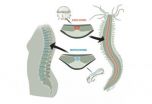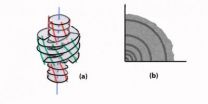(Press-News.org) When corn plants come under attack from a pathogen, they sometimes respond by killing their own cells near the site of the attack, committing "cell suicide" to thwart further damage from the attacker. This cell sacrifice can cause very small, often microscopic, spots or lesions on the plant.
But up until now it's been difficult to understand how the plant regulates this "spotty" defense mechanism because the response is so quick and localized.
Researchers at North Carolina State University have identified a number of candidate genes and cellular processes that appear to control this so-called hypersensitive defense response (HR) in corn. The findings, which appear in PLOS Genetics, could help researchers build better defense responses in corn and other plants; HR is thought to occur in all higher-order plants, including all trees and crop plants, and is normally a tightly regulated response.
The 44 candidate genes appear to be involved in defense response, programmed cell death, cell wall modification and a few other responses linked to resisting attack, says Dr. Peter Balint-Kurti, the paper's corresponding author and a U.S. Department of Agriculture (USDA) professor who works in NC State's plant pathology and crop science departments.
To arrive at the finding, the NC State researchers joined researchers from Purdue University in examining more than 3,300 maize plants that contained a similar mutation: They all had exaggerated HR because one particular resistance gene, Rp1-D21, doesn't turn off.
"It's similar to a human having an auto-immune response that never stops," Balint-Kurti says. "This mutation causes a corn plant to inappropriately trigger this hypersensitive defense response, causing spots on the corn plant as well as stunted growth."
The researchers examined the entire corn gene blueprint – some 26.5 million points in the 2 to 3 billion base pair genome – to find the genes most closely associated with HR. Balint-Kurti said the top candidates made sense, as they mostly appear to be linked to defense or disease resistance.
"All of the processes associated with the top candidate genes have been previously associated with HR," Balint-Kurti said. "Hopefully this work provides an opening to really characterize this important defense response and learn more about it in other plants."
INFORMATION:
USDA plant geneticist and breeder Jim Holland co-authored the paper along with first authors Bode Olukolu and Guan Feng Wang, who are post-doctoral researchers at NC State. Vijay Vontimitta, a post-doctoral researcher at Purdue working in a group headed by Guri Johal, is also a first author.
The research was funded by USDA, the National Science Foundation, NC State and Purdue University.
Note: An abstract of the paper follows.
"Multivariate Analysis of Maize Disease Resistance Suggests a Pleiotropic Genetic Basis and Implicates a Glutathione S-transferase Gene"
Authors: Bode A. Olukolu, Guan Feng Wang, Adisu Negeri, Dahlia Nielsen, James Holland and Peter Balint-Kurti, North Carolina State University; Vijay Vontimitta, Bala Venkata, Sandeep Marla, Jiabing Ji, Emma Gachomo, Kevin Chu and Gurmukh Johal, Purdue University; Jacqueline Benson, Rebecca Nelson and Peter Bradbury, Cornell University
Published: Aug. 28, 2014, in PLOS Genetics
DOI: 10.1371/journal.pgen.1004562
Abstract: Much remains unknown of molecular events controlling the plant hypersensitive defense response (HR), a rapid localized cell death that limits pathogen spread and is mediated by resistance (R-) genes. Genetic control of the HR is hard to quantify due to its microscopic and rapid nature. Natural modifiers of the ectopic HR phenotype induced by an aberrant auto-active R-gene (Rp1-D21), were mapped in a population of 3,381 recombinant inbred lines from the maize nested association mapping population. Joint linkage analysis was conducted to identify 32 additive but no epistatic quantitative trait loci (QTL) using a linkage map based on more than 7000 single nucleotide polymorphisms (SNPs). Genome-wide association (GWA) analysis of 26.5 million SNPs was conducted after adjusting for background QTL. GWA identified associated SNPs that colocalized with 44 candidate genes. Thirty-six of these genes colocalized within 23 of the 32 QTL identified by joint linkage analysis. The candidate genes included genes predicted to be in involved programmed cell death, defense response, ubiquitination, redox homeostasis, autophagy, calcium signalling, lignin biosynthesis and cell wall modification. Twelve of the candidate genes showed significant differential expression between isogenic lines differing for the presence of Rp1-D21. Low but significant correlations between HR-related traits and several previously-measured disease resistance traits suggested that the genetic control of these traits was substantially, though not entirely, independent. This study provides the first system-wide analysis of natural variation that modulates the HR response in plants.
Corn spots: Study finds important genes in defense response
2014-09-12
ELSE PRESS RELEASES FROM THIS DATE:
Experts call for massive global response to tackle Ebola
2014-09-12
AUDIO:
Professor Peter Piot, Director of the London School of Hygiene & Tropical Medicine, explains how he co-discovered the Ebola virus in 1976, and gives his views on the current Ebola...
Click here for more information.
The current Ebola outbreak now requires a "rapid response at a massive global scale", according to experts at the London School of Hygiene & Tropical Medicine.
Writing an editorial in Science, Professor Peter Piot, co-discoverer of the virus, says that the ...
Stanford-led study assesses the environmental costs and benefits of fracking
2014-09-12
A strange thing happened on the way to dealing with climate change: Advances in hydraulic fracturing put trillions of dollars' worth of previously unreachable oil and natural gas within humanity's grasp.
The environmental costs – and benefits – from "fracking," which requires blasting huge amounts of water, sand and chemicals deep into underground rock formations, are the subject of new research that synthesizes 165 academic studies and government databases. The survey covers not only greenhouse gas impacts but also fracking's influence on local air pollution, earthquakes ...
Piglet health
2014-09-12
Porcine neonatal coccidiosis is a serious parasitic infection of young piglets that severely damages the intestinal mucosa, leading to diarrhoea and reduced nutritional intake. As the infection reduces animal growth, and because secondary infections can result in increased mortality, the disease is responsible for substantial economic losses at affected pig farms.
"The developing immune system of neonatal piglets is not yet mature enough to deal with the parasites. For this reason, an infection shortly after birth results in weakened intestinal tissue with appropriate ...
Moving silicon atoms in graphene with atomic precision
2014-09-12
Richard Feynman famously posed the question in 1959: is it possible to see and manipulate individual atoms in materials? For a time his vision seemed more science fiction than science, but starting with groundbreaking experiments in the late 1980s and more recent developments in electron microscopy instrumentation it has become scientific reality. However, damage caused by the electron beam is often an issue in such experiments.
The present study focused on single-layer graphene with silicon atoms embedded into the lattice, previously created and studied by the collaborators ...
Cutting the cloud computing carbon cost
2014-09-12
Cloud computing involves displacing data storage and processing from the user's computer on to remote servers. It can provide users with more storage space and computing power that they can then access from anywhere in the world rather than having to connect to a single desktop or other computer with its finite resources. However, some observers have raised concerns about the increased energy demands of sustaining distributed servers and having them up and running continuously, where an individual user's laptop might be shut down when it is not in use or the resources utilization ...
From worm muscle to spinal discs
2014-09-12
Thoughts of the family tree may not be uppermost in the mind of a person suffering from a slipped disc, but those spinal discs provide a window into our evolutionary past. They are remnants of the first vertebrate skeleton, whose origins now appear to be older than had been assumed. Scientists at the European Molecular Biology Laboratory (EMBL) in Heidelberg, Germany, have found that, unexpectedly, this skeleton most likely evolved from a muscle. The study, carried out in collaboration with researchers at the Howard Hughes Medical Institute in Janelia Farm, USA, is published ...
New family of materials for energy-efficient information storage and processing
2014-09-12
Switching the polarity of a magnet using an electric field (magnetoelectric memory [MEM] effect), can be a working principle of the next-generation technology for information processing and storage. Multiferroic materials are promising candidates for the MEM effect, due to the coexistence of electric and magnetic orders. On the other hand, the coexistence of spontaneous electric and magnetic polarizations is rare in known materials, which hinders the application potential of the MEM effect. This article briefly reviews a new family of multiferroic materials—hexagonal rare ...
Conjecture on the lateral growth of Type I collagen fibrils
2014-09-12
Whatever the origin and condition of extraction of type I collagen fibrils, in vitro as well as in vivo, the radii of their circular circular cross sections stay distributed in a range going from 50 to 100 nm for the most part of them. Jean Charvolin and Jean-Francois Sadoc from the solid state physique laboratory at the Paris-Sud University propose therefore that, once the growth of the fibrils has been triggered by external biological factors, their lateral size be limited by internal physical stresses generated during the growth. Their conjecture is based ...
Extension of standard model by knot algebra
2014-09-12
This paper makes a connection between the quantum group SLq(2), which described knots, and the elementary particles of the standard model. The elements of the fundamental (j = 1/2) representation of SLq(2) are interpreted as creation operators for preons. The preons interact through a preonic vector field defined by elements of the adjoint (j = 1) representation. The leptons and quarks then appear (as required by the electroweak data) as elements of the j = 3/2 representation. Unexpectedly the electroweak quantum numbers of the so defined preons, leptons, and quarks agree ...
Scientists show that nicotine withdrawal reduces response to rewards across species
2014-09-12
Cigarette smoking is a leading cause of preventable death worldwide and is associated with approximately 440,000 deaths in the United States each year, according to the U.S. Centers for Disease Control and Prevention, but nearly 20 percent of the U.S. population continues to smoke cigarettes. While more than half of U.S. smokers try to quit every year, less than 10 percent are able to remain smoke-free, and relapse commonly occurs within 48 hours of smoking cessation. Learning about withdrawal and difficulty of quitting can lead to more effective treatments to help smokers ...





